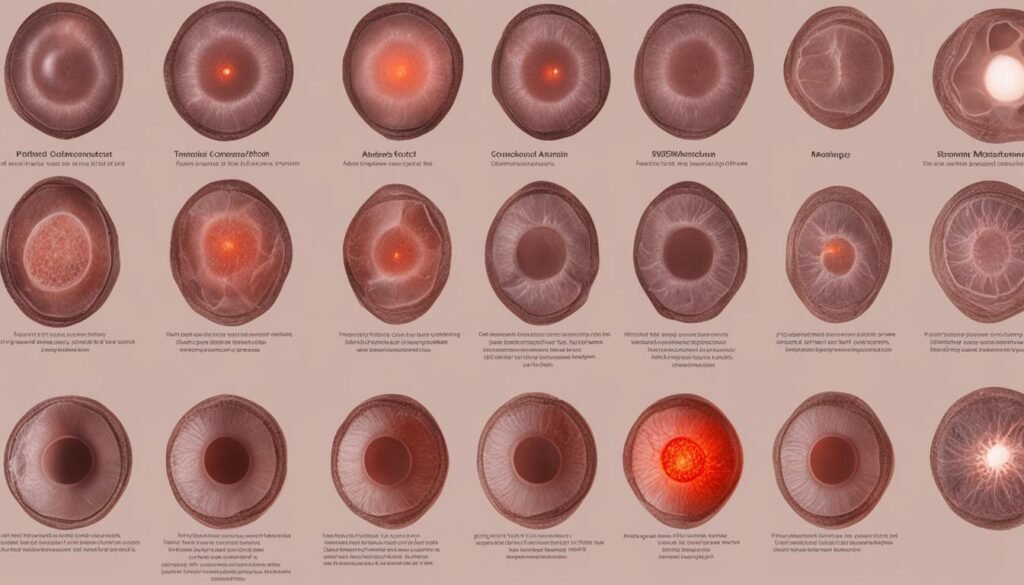Contents
- 1 How Photodynamic Therapy Works
- 2 Pros and Cons of Photodynamic Therapy
- 3 Uses of Photodynamic Therapy
- 4 Photodynamic Therapy Drugs Approved by FDA
- 5 Side Effects of Photodynamic Therapy
- 6 Conclusion
- 7 FAQ
- 7.1 What is photodynamic therapy (PDT)?
- 7.2 How does photodynamic therapy (PDT) work?
- 7.3 What are the advantages and disadvantages of photodynamic therapy (PDT)?
- 7.4 What are the uses of photodynamic therapy (PDT)?
- 7.5 What drugs are approved by the FDA for photodynamic therapy (PDT)?
- 7.6 What are the side effects of photodynamic therapy (PDT)?
- 7.7 What is the conclusion of photodynamic therapy (PDT)?
- 8 Source Links
Photodynamic therapy (PDT) is a revolutionary treatment method for various health conditions. It uses special drugs, called photosensitizing agents, along with light to kill cancer cells. The drugs are activated by specific kinds of light, which then react and form a special kind of oxygen molecule that kills the cells. PDT can also destroy blood vessels that feed the cancer cells and stimulate the immune system to attack the cancer. It is used as a local treatment for specific parts of the body.
Key Takeaways:
- Photodynamic therapy (PDT) is a treatment method that combines drugs and light to kill cancer cells.
- PDT can destroy blood vessels that feed cancer cells and stimulate the immune system to fight against cancer.
- PDT is a local treatment used for specific parts of the body.
- It is a promising option for treating various health conditions, particularly localized cancers.
- Consult with your doctor to determine if PDT is a suitable treatment method for your health condition.
How Photodynamic Therapy Works
In photodynamic therapy (PDT), photosensitizers are absorbed by the cancer cells and are activated by specific wavelengths of light. The activated photosensitizers produce oxygen radicals that kill the cancer cells. PDT can also damage blood vessels in the tumor, cutting off its blood supply, and trigger the immune system to attack tumor cells. The light used in PDT can come from lasers or light-emitting diodes (LEDs), depending on the type and location of the cancer.
When photosensitizers are administered to a patient, they tend to accumulate at a higher concentration in cancer cells compared to normal cells. This preferential uptake is enhanced by the fact that cancer cells typically have a higher metabolic rate and increased blood supply. Once the photosensitizers have been absorbed, they remain in an inactive state until they are activated by light of a specific wavelength. Light activation causes the photosensitizers to undergo a chemical reaction, generating reactive oxygen species (ROS) such as singlet oxygen. These ROS are highly toxic and can induce cell death through apoptosis, necrosis, or autophagy.
Photodynamic therapy utilizes the synergistic effects of photosensitizers and light to selectively target and destroy cancer cells while sparing the surrounding healthy tissue. This precision targeting is one of the key advantages of PDT, as it minimizes damage to normal cells and reduces side effects.
In addition to directly killing cancer cells, PDT can also disrupt the tumor microenvironment by damaging blood vessels that supply nutrients to the tumor. By cutting off the tumor’s blood supply, PDT starves the cancer cells and reduces their ability to grow and spread. Furthermore, PDT has been shown to stimulate an immune response, activating the body’s natural defense mechanisms to recognize and attack tumor cells that have not been directly targeted by the therapy.
Table: Comparison of Photodynamic Therapy Mechanism and Other Cancer Treatments
| Treatment | Mechanism | Side Effects |
|---|---|---|
| Photodynamic Therapy (PDT) | Photosensitizers activated by light produce toxic oxygen radicals that kill cancer cells. Can also damage blood vessels and stimulate immune response. | Minimal long-term side effects, photosensitivity reactions, swelling, pain, immune system changes. |
| Chemotherapy | Chemicals target rapidly dividing cancer cells throughout the body, but also affect healthy cells. | Nausea, hair loss, fatigue, weakened immune system, risk of infection. |
| Radiation Therapy | High-energy radiation damages DNA in cancer cells, preventing cell division and growth. | Skin changes, fatigue, hair loss, nausea, risk of secondary cancers. |
| Surgery | Physical removal of cancerous tissue or tumors. | Pain, infection, bleeding, scarring, risk of complications. |
Photodynamic therapy offers a unique and targeted approach to cancer treatment, utilizing the interaction between photosensitizers and light to selectively destroy cancer cells. While PDT has its limitations, such as the requirement for light to reach the treatment area and the inability to treat deeply penetrated or widely spread tumors, it continues to show promise in the management of various health conditions. Ongoing research and development in the field aim to enhance the effectiveness of PDT and expand its applications, making it a valuable addition to the arsenal of cancer treatment options.
Pros and Cons of Photodynamic Therapy
Photodynamic therapy (PDT) offers several advantages as a treatment option for various health conditions, particularly localized cancers. Understanding the advantages and disadvantages of PDT can help patients make informed decisions about their treatment.
Advantages of Photodynamic Therapy
PDT has several advantages that make it an attractive option for patients and healthcare providers. Firstly, when used properly, PDT has no long-term side effects, unlike other cancer treatments that can have lasting impacts on the body. This means that patients can undergo PDT without the fear of experiencing significant adverse effects in the future.
Secondly, PDT is a less invasive treatment method compared to surgery. It does not involve cutting or incisions, making it a less traumatic experience for patients. This also leads to faster recovery times and reduced hospital stays.
Another advantage of PDT is its precision targeting. The treatment can be focused on specific areas of the body, ensuring that healthy tissues are spared from unnecessary damage. This targeted approach minimizes the risk of complications and improves patient outcomes.
Limitations of Photodynamic Therapy
While PDT offers numerous advantages, it also has limitations that should be considered. One of the main limitations is that PDT can only treat areas where light can reach. This makes it suitable for superficial or localized cancers that are close to the skin or accessible by endoscopy. Large or deeply penetrated tumors may not be effectively treated with PDT.
Additionally, PDT may not be suitable for cancers that have spread widely or metastasized to multiple places in the body. It is important to assess the stage and extent of the cancer before considering PDT as a treatment option.
Despite these limitations, photodynamic therapy remains an important and valuable treatment method for localized cancers. By understanding the advantages and limitations of PDT, patients and healthcare providers can make informed decisions about the most appropriate treatment plan for each individual.
Table: Pros and Cons of Photodynamic Therapy
| Advantages | Disadvantages |
|---|---|
| PDT has no long-term side effects | Restricted to areas where light can reach |
| Less invasive than surgery | Ineffective for large or deeply penetrated tumors |
| Short treatment time | Not suitable for widely spread cancers |
| Can be targeted very precisely | |
| Can be repeated multiple times if needed | |
| Lower cost compared to other cancer treatments |
Uses of Photodynamic Therapy

Photodynamic therapy (PDT) is a versatile treatment method that is particularly effective for localized cancers. Its unique mechanism of action allows for targeted treatment of specific areas, making it a valuable option for several cancer types and pre-cancerous conditions.
Applications in Cancer Treatment
PDT is widely used to treat various types of localized cancers. One of its primary applications is in the treatment of esophageal cancer. PDT can help alleviate symptoms such as difficulty swallowing caused by the tumor blocking the throat. It is also a valuable treatment option for non-small cell lung cancer, especially when the tumor blocks the airways, causing breathing difficulties.
PDT is also effective in treating skin cancers, such as basal cell skin cancer and actinic keratosis. These cancers typically occur on the surface of the skin, making them ideal targets for PDT’s light-based therapy. By directly targeting the cancer cells on the skin, PDT can destroy them and minimize damage to the surrounding healthy tissue.
Localized Cancers
It’s important to note that PDT is most effective for localized cancers that have not spread far from their point of origin. The treatment relies on light activation of photosensitizers in the specific area being treated. Therefore, PDT may not be suitable for large or deeply penetrated tumors or cancers that have metastasized extensively.
Photodynamic Therapy Drugs Approved by FDA
Photodynamic therapy (PDT) has gained recognition as an effective treatment option for various types of cancer and pre-cancerous conditions. The US Food and Drug Administration (FDA) has approved several photosensitizing agents for use in PDT, providing patients with more options for their cancer treatment journeys. Two widely-used PDT drugs that have received FDA approval are Porfimer sodium (Photofrin) and Aminolevulinic acid (ALA or Levulan).
Porfimer sodium, also known as Photofrin, is activated by red light and is used as a treatment for esophageal and lung cancer, as well as actinic keratosis. It is administered intravenously, allowing it to reach cancer cells throughout the body. Aminolevulinic acid (ALA or Levulan) is a topical agent applied to the skin and activated by blue light. It is commonly used to treat actinic keratosis and has shown promise in the treatment of other skin conditions as well.
PDT Drugs Approved by FDA
| PDT Drug | Activation Light | Approved Uses |
|---|---|---|
| Porfimer sodium (Photofrin) | Red light | Esophageal cancer, Lung cancer, Actinic keratosis |
| Aminolevulinic acid (ALA or Levulan) | Blue light | Actinic keratosis, Skin conditions |
| Additional PDT drugs | Varying wavelengths | Under development |
It is important to note that while these PDT drugs have been approved for specific uses, ongoing research is being conducted to explore their potential in treating additional types of cancer and pre-cancerous conditions. Scientists and medical professionals are continuously working to develop new PDT drugs and refine existing treatment protocols to improve patient outcomes.
During PDT treatment, the specific PDT drug used, along with the appropriate activation light, plays a crucial role in the success of the therapy. The choice of PDT drug depends on the type and location of the cancer being treated, as well as the patient’s individual circumstances. Consulting with a healthcare professional is essential to determine the most suitable PDT drug for each patient’s specific needs.
Side Effects of Photodynamic Therapy

Photodynamic therapy (PDT) is a highly effective treatment method for various health conditions, particularly localized cancers. However, like any medical procedure, PDT can have side effects that vary from person to person. It’s essential to be aware of these potential side effects to make informed decisions about your treatment. Here are some common side effects associated with PDT:
Photosensitivity Reactions
One of the most common side effects of photodynamic therapy is photosensitivity reactions. This occurs because the photosensitizing agent used in PDT makes your skin more sensitive to light. After treatment, you may experience redness, tingling, or burning sensations on the treated skin when exposed to sunlight or other sources of light. To minimize these reactions, it’s crucial to protect yourself from direct sunlight, wear protective clothing, and use a broad-spectrum sunscreen with a high SPF rating.
Skin Changes
During photodynamic therapy, you may notice temporary skin changes in the treated area. These changes can include redness, swelling, itching, or the formation of blisters. These effects typically subside within a few weeks after treatment. If you have concerns about skin changes, it’s important to discuss them with your healthcare provider for proper management and reassurance.
Swelling and Pain
Some individuals may experience swelling and pain in the treated area after photodynamic therapy. This can be managed with over-the-counter pain medications or prescribed pain relievers, as recommended by your healthcare provider. It’s important to follow post-treatment care instructions and report any severe or persistent pain to your healthcare provider immediately.
Immune System Changes
PDT can stimulate the immune system to work more efficiently, which is often a desired effect in cancer treatment. However, in rare cases, PDT may weaken the immune system. If you notice any signs of a weakened immune system, such as frequent infections or slow wound healing, it’s essential to seek medical attention promptly. Your healthcare provider can assess your immune status and provide appropriate guidance.
While these side effects can occur with photodynamic therapy, it’s crucial to remember that they are generally temporary and manageable. The benefits of PDT often outweigh the potential risks, especially when used to treat localized cancers. If you have any concerns or questions about PDT’s side effects, don’t hesitate to discuss them with your healthcare provider to ensure the best possible treatment experience.
Conclusion
In conclusion, photodynamic therapy (PDT) is a highly promising treatment method for various health conditions, particularly localized cancers. It offers a range of benefits that make it a valuable option for patients. One of the key advantages of PDT is its minimal long-term side effects, making it a relatively safe treatment option. Additionally, PDT is less invasive than surgery and can often be completed on an outpatient basis, reducing the overall impact on patients.
Another significant benefit of PDT is its precision targeting. By using specific wavelengths of light, PDT can be focused on the affected area, minimizing damage to surrounding healthy tissues. This precision also allows for multiple treatments if needed, improving the efficacy of the therapy. Furthermore, PDT is often more cost-effective compared to other cancer treatments, making it a more accessible option for patients.
However, it is important to acknowledge the limitations of PDT. One major limitation is its inability to treat large or deeply penetrated tumors. PDT is most effective for localized cancers that have not spread widely. Additionally, the treatment can only be administered in areas where light can reach, making it unsuitable for certain types of cancers that are located in inaccessible regions. These limitations highlight the need for further research and development of new PDT drugs and treatment approaches.
In summary, despite its limitations, photodynamic therapy (PDT) holds great promise as a targeted treatment method for localized cancers. With its minimal long-term side effects, precision targeting, and cost-effectiveness, PDT offers patients a viable alternative to traditional cancer treatments. As research continues to advance and new drugs are developed, PDT may become an even more widely used therapy option. Patients are encouraged to consult with their healthcare providers to determine if PDT is a suitable choice for their specific condition.
FAQ
What is photodynamic therapy (PDT)?
Photodynamic therapy is a treatment method that uses special drugs and light to kill cancer cells and destroy blood vessels that feed the cancer cells.
How does photodynamic therapy (PDT) work?
In PDT, photosensitizers are absorbed by cancer cells and activated by specific wavelengths of light, producing oxygen radicals that kill the cancer cells. It can also damage blood vessels in the tumor and trigger the immune system to attack tumor cells.
What are the advantages and disadvantages of photodynamic therapy (PDT)?
PDT has advantages such as minimal long-term side effects, precision targeting, short treatment time, and lower costs compared to other cancer treatments. However, it has limitations, such as the inability to treat large or deeply penetrated tumors and cancers that have spread widely.
What are the uses of photodynamic therapy (PDT)?
PDT is used to treat various cancers and pre-cancers, including esophageal cancer, lung cancer, basal cell skin cancer, and actinic keratosis. It can also be used to relieve symptoms of certain cancers, such as esophageal cancer blocking the throat or non-small cell lung cancer blocking the airways.
What drugs are approved by the FDA for photodynamic therapy (PDT)?
Two widely used PDT drugs are Porfimer sodium (Photofrin), activated by red light, and Aminolevulinic acid (ALA or Levulan), applied topically and activated by blue light. They have been approved for the treatment of cancers such as esophageal and lung cancer, as well as actinic keratosis.
What are the side effects of photodynamic therapy (PDT)?
The most common side effect is photosensitivity reactions, which cause redness, tingling, or burning sensations on the treated skin. Other side effects may include swelling, pain, skin changes like redness, swelling, itching, or blisters, and immune system changes.
What is the conclusion of photodynamic therapy (PDT)?
PDT is a promising treatment method for localized cancers, offering benefits such as minimal long-term side effects, precision targeting, short treatment time, and lower costs. However, it has limitations in treating large or deeply penetrated tumors and widespread cancers.



